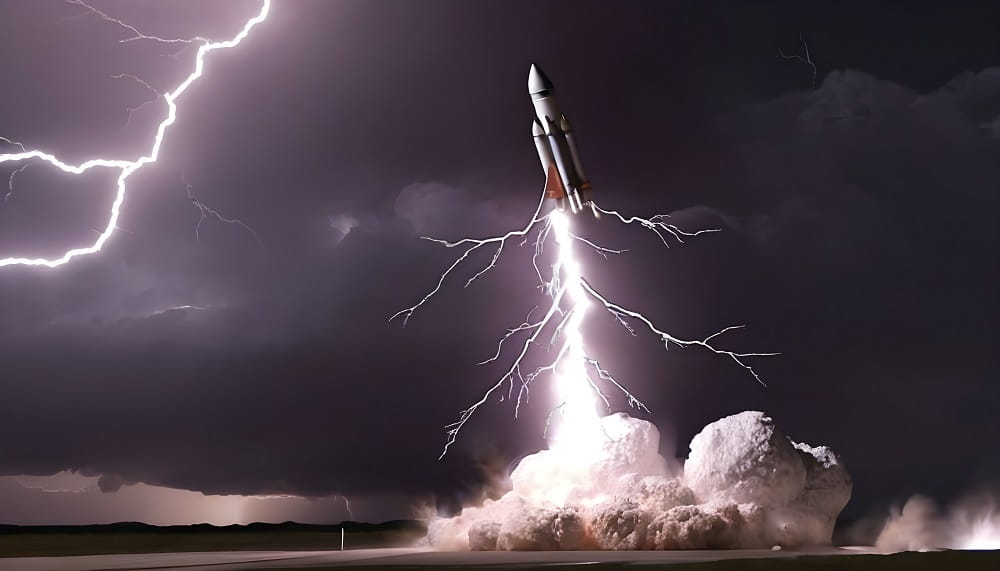The history of space exploration is filled with remarkable stories of courage, ingenuity, and the triumph of human spirit over the unknown. Among these tales, one incident stands out as particularly electrifying: the day lightning touched a spacecraft.
On November 14, 1969, during the launch of Apollo 12, the world watched in awe as the mighty Saturn V rocket roared to life, carrying astronauts Charles "Pete" Conrad, Richard F. Gordon Jr., and Alan L. Bean toward the heavens. But just seconds after liftoff, the mission encountered an unexpected and potentially catastrophic event—lightning struck the spacecraft not once, but twice.
But despite the harrowing challenges, Apollo 12 ultimately achieved its objective, with Conrad and Bean becoming the third and fourth humans to set foot on the lunar surface. Their triumphant return to Earth marked not only a historic milestone in space exploration but also a testament to the indomitable spirit of exploration that drives humanity ever onward.
The Explanation Behind Apollo 12's Electrifying EncounterApollo 12, the second manned mission to land on the Moon, encountered a dramatic and electrifying event during its launch. Just seconds after liftoff, the lightning bolts, unleashed by a tumultuous storm raging over the Kennedy Space Center, delivered a powerful blow to the Apollo 12 spacecraft, causing alarms to blare and systems to falter. The spacecraft experienced not one, but two strikes from lightning bolts. This unexpected occurrence, later known as the "double lightning strike," presented a serious threat to the mission's success and the safety of the crew. However, through quick thinking and decisive action, the astronauts and mission control were able to overcome the challenges posed by this extraordinary event.
The Apollo 12 mission had already faced setbacks prior to launch, with inclement weather causing delays. Nevertheless, when the launch finally commenced, it seemed as though the mission was back on track. However, mere moments after liftoff, the Saturn V rocket carrying the Apollo spacecraft was struck by lightning not once, but twice. The intense electrical discharge temporarily knocked out power to essential systems and caused numerous warning lights to illuminate in the cockpit.
Despite the chaos ensuing in the spacecraft, the crew—Commander Charles "Pete" Conrad, Command Module Pilot Richard F. Gordon Jr., and Lunar Module Pilot Alan L. Bean—remained calm and focused. With lightning flashing outside the windows and alarms blaring, they quickly assessed the situation and took appropriate action to stabilize the spacecraft.
One crucial decision made by the crew was to continue with the mission rather than aborting. This decision was based on their assessment that the damage caused by the lightning strikes was manageable and did not pose an immediate threat to the safety of the mission. Additionally, mission control provided invaluable support and guidance, helping the crew to troubleshoot and resolve the issues caused by the lightning strikes.
One of the most critical tasks facing the crew was to reactivate the fuel cells, which had been temporarily disabled by the lightning strikes. These fuel cells were essential for providing electrical power to the spacecraft and its systems. Through a series of manual procedures, the crew was able to successfully reactivate the fuel cells, restoring power to the spacecraft and allowing the mission to continue.
Despite the initial setback, Apollo 12 went on to achieve its primary objective of landing two astronauts—Conrad and Bean—on the lunar surface. The successful landing and subsequent exploration of the Moon's surface demonstrated the resilience and determination of the astronauts and the teams supporting them on the ground.
In the aftermath of the "double lightning strike," NASA conducted thorough investigations to understand how such an event could have occurred and to implement measures to prevent similar incidents in future missions. These investigations led to improvements in the design and operation of spacecraft, as well as enhanced safety protocols for handling adverse weather conditions during launches.
The electrifying encounter experienced by Apollo 12 serves as a reminder of the inherent risks associated with space exploration and the importance of preparedness, quick thinking, and teamwork in overcoming unexpected challenges. Despite facing the forces of nature and the unknown, the crew of Apollo 12 demonstrated courage, resourcefulness, and determination, ultimately paving the way for the success of the mission and the advancement of human exploration beyond the bounds of Earth.














0 comments:
Post a Comment